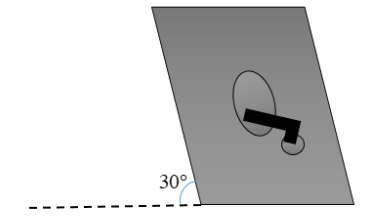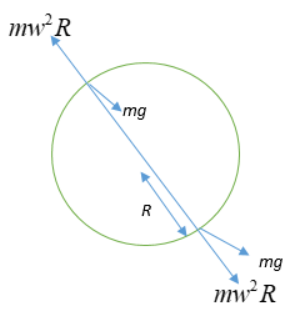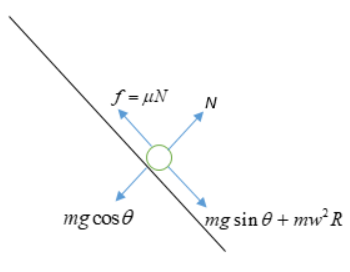
An old record player of \[15.0cm\] radius turns at \[33.0\] rev min-1 while mounted on a \[30{}^\circ \] incline as shown in fig.
a) If a mass m can be placed anywhere on the rotating record, where is the most critical place on the disc where slipping might occur.
b) Calculate the least possible coefficient of friction that must exist if no slipping occurs.


Answer
555.3k+ views
Hint: As the Disc is moving on the record player so, there is a centrifugal force which acts outwards from the Center of disc. Also the frictional Force acts opposite to the motion of the record player.
Complete answer:
Given radius of record player \[15.0\text{ }cm\] turns with \[33.0\] revolution/minutes
Record player mounted on an inclination of \[30{}^\circ \]
(a)

At the topmost point, a gravitational force will act downwards while the centrifugal force will act upward. At the bottom corner of the disc, the centrifugal force and the gravitational force, both act downward. Hence, the net force is very large at this point. So, the bottom most point at the corner is the most critical point for slipping.
(b) No slipping occurs.

Component of mg in the direction along the plane is \[mg\sin \theta \]
Centrifugal force \[m{{w}^{2}}R\] in the direction of a Normal force act perpendicular to the disc surface.
Friction forces act in the opposite direction of motion.
So, By balancing equation,
\[f=\mu N\text{ }\left( 1 \right)\]
\[N=mg\cos \theta \text{ }\left( 2 \right)\]
\[f=mg\sin \theta +m{{w}^{2}}R\text{ }\left( 3 \right)\]
Substituting values from equation 1 and 2 to 3
\[\mu mg\cos \theta =mg\sin \theta +m{{w}^{2}}R\]
\[\mu mg\cos \theta =g\sin \theta +{{w}^{2}}R\]
\[\Rightarrow \mu =\tan \theta +\dfrac{{{w}^{2}}R}{g\cos \theta }\]
\[\Rightarrow \text{As}\Rightarrow w=33\text{ revol}\text{./Min}\]
\[=2\pi \times \dfrac{33}{60}\dfrac{rad}{\sec }\]
\[=1.1rad/\sec .\]
So, \[\mu =\tan 30{}^\circ +\dfrac{{{\left( 1.1 \right)}^{2}}\times 0.15}{9.8\times \cos 30}\]
\[\mu =.5773+0.21385\]
\[\mu =0.5986\]
Hence, the least possible coefficient of friction is \[\mu =0.5986\]
Note:
At the lower bottom point where centrifugal force and mg will be minimum behaves as a most Critical point when the angle of inclination is\[30{}^\circ \]. Also should be aware during calculating of driving force.
Complete answer:
Given radius of record player \[15.0\text{ }cm\] turns with \[33.0\] revolution/minutes
Record player mounted on an inclination of \[30{}^\circ \]
(a)

At the topmost point, a gravitational force will act downwards while the centrifugal force will act upward. At the bottom corner of the disc, the centrifugal force and the gravitational force, both act downward. Hence, the net force is very large at this point. So, the bottom most point at the corner is the most critical point for slipping.
(b) No slipping occurs.

Component of mg in the direction along the plane is \[mg\sin \theta \]
Centrifugal force \[m{{w}^{2}}R\] in the direction of a Normal force act perpendicular to the disc surface.
Friction forces act in the opposite direction of motion.
So, By balancing equation,
\[f=\mu N\text{ }\left( 1 \right)\]
\[N=mg\cos \theta \text{ }\left( 2 \right)\]
\[f=mg\sin \theta +m{{w}^{2}}R\text{ }\left( 3 \right)\]
Substituting values from equation 1 and 2 to 3
\[\mu mg\cos \theta =mg\sin \theta +m{{w}^{2}}R\]
\[\mu mg\cos \theta =g\sin \theta +{{w}^{2}}R\]
\[\Rightarrow \mu =\tan \theta +\dfrac{{{w}^{2}}R}{g\cos \theta }\]
\[\Rightarrow \text{As}\Rightarrow w=33\text{ revol}\text{./Min}\]
\[=2\pi \times \dfrac{33}{60}\dfrac{rad}{\sec }\]
\[=1.1rad/\sec .\]
So, \[\mu =\tan 30{}^\circ +\dfrac{{{\left( 1.1 \right)}^{2}}\times 0.15}{9.8\times \cos 30}\]
\[\mu =.5773+0.21385\]
\[\mu =0.5986\]
Hence, the least possible coefficient of friction is \[\mu =0.5986\]
Note:
At the lower bottom point where centrifugal force and mg will be minimum behaves as a most Critical point when the angle of inclination is\[30{}^\circ \]. Also should be aware during calculating of driving force.
Recently Updated Pages
Why are manures considered better than fertilizers class 11 biology CBSE

Find the coordinates of the midpoint of the line segment class 11 maths CBSE

Distinguish between static friction limiting friction class 11 physics CBSE

The Chairman of the constituent Assembly was A Jawaharlal class 11 social science CBSE

The first National Commission on Labour NCL submitted class 11 social science CBSE

Number of all subshell of n + l 7 is A 4 B 5 C 6 D class 11 chemistry CBSE

Trending doubts
What is meant by exothermic and endothermic reactions class 11 chemistry CBSE

10 examples of friction in our daily life

One Metric ton is equal to kg A 10000 B 1000 C 100 class 11 physics CBSE

1 Quintal is equal to a 110 kg b 10 kg c 100kg d 1000 class 11 physics CBSE

Difference Between Prokaryotic Cells and Eukaryotic Cells

What are Quantum numbers Explain the quantum number class 11 chemistry CBSE




